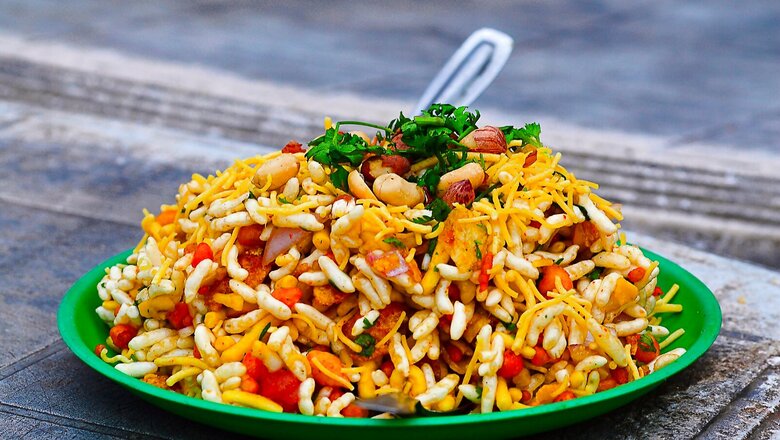
views
Food eggheads, vloggers, bloggers, journalists and reviewers often talk about the Vada Pav being the archetypal, quintessential Mumbai food. I beg to differ. Unlike most of these pundits with posits, I along with most of my ancestors was born in this city and we have a slight difference of opinion. I would like to anoint the simple Bhel Puri as the paradigmatic Mumbai food, and I have a couple of reasons for that. First, growing up in the ‘60s and ‘70s in this city, there was only Batata Vada, and no such thing as a Vada Pav. I’m guessing that’s why, although I adore bread, I still prefer eating a plate of Batata Vada with chutney, than munching into a Vada Pav. But the food that was ubiquitous and omnipresent was — the Bhel Puri.
What’s more, I lived off Marine Drive and Chowpatty Beach was a hop, skip and a bhel away. For some reason, Bhel Puri became synonymous with Chowpatty or was it the other way around? Chowpatty Beach, filthy as it was, was home to a considerable number of Bhel Puri stalls. Around 3 every afternoon, you could see a sudden spurt of activity in the stalls which wore a deserted look most of the morning. There would be the sounds of utensils being washed, masalas being ground, pots of chutneys being stirred, piles of onions, coriander and green chillies being noisily chopped on wooden boards and the general clang and clink of preparation.
Most of the Bhel Puri walas at Chowpatty Beach were large-bellied, mustachioed men with well-oiled hair, sporting a choti. They hailed from the North and spoke in a Bambaiya bhelpuri version of Hindi-Bhojpuri-Braj bhasha, and their forefathers I am assuming brought this distinctly North Indian dish, gave it a Bombay flavour and called it Bhel Puri.
Bhel Puri is a kind of chaat, and chaat is such a North Indian thing, after all. Nearly every town, district or city in North India like Delhi, Jaipur, Mathura has its own chaat culture. Mathura, for example, is famous for the samosas, kachoris, jalebis, pooris and Dubki Wale Aloo (bits of potato dunked in thin, spicy gravy). Or Varanasi, where every little lane is filled with the fragrance of incense and the aroma of puris being cooked in desi ghee. These migrants brought their time-honoured flavours and spices and methods of North India, mixed them with some ingredients (flattened puris, thin sev, puffed rice, gathia, besan and sprouts) undoubtedly finding their origins in Gujarati farsan, and created Mumbai’s very own Bhel Puri.
The Bhel is puffed rice mixed with onion, potato and three kinds of chutney (green coriander-chilli, red garlic and brown tamarind-jaggery) sprinkled generously with sev and garnished with lemon juice, masalas, coriander and slivers of raw mango. Back in the days, Bhel was always served in cones made out of pieces of old newspapers or pages torn from discarded annual reports. It was much later that paper plates and other such luxuries made their appearance. The same Bhel laid out neatly on six puris transforms into Sev Puri or Lala Puri (without the puffed rice).
In those days there were two kinds of vendors, the Bhel Puri wala and the Paani Puri wala, and their wares never mixed. The Bhel Puri wala only sold Bhel Puri and Sev Puri. The Paani Puri wala sold Paani Puri (with hollow puris stuffed with sprouts, potato, chilled jeera water) or Dahi Batata Puri, with curd added to the mix and dahi wadas. Vithal Bhel Wala behind New Empire Cinema, Fort (established in 1875), is still famous for his Bhel Puri (they claim to have invented it here, but that’s apocryphal and neither here nor there). Princess Kulfi House on Princess Street was one of the more hygienic places to grab a Kulfi and a Sev Puri. It was impossible to find a table at Jai Hind Bhel Puri at Nana Chowk. Even the menus of old colonial clubs like the Cricket Club of India, Bombay Gymkhana and The Willingdon Club flaunted Bhel and Sev Puri, alongside Welsh Rarebit (hot cheese-based sauce served over slices of toasted bread) and Devils on Horseback (dates stuffed with cheese and wrapped in bacon).
Even today one of my favourite things to order at the iconic ‘Sea Lounge’ at the Taj Palace Hotel in Mumbai is the Sev Puri. There is no better feeling than the one you get on a rainy day, when you find a window seat at the plush, carpeted, sprawling ‘Sea Lounge’ looking out at the grey thunderous clouds and the waves thrashing at the stone walls of Apollo Bunder, and the Gateway of India washed clean with the rain. And, when you order a plate of Sev Puri with a tall glass of Vanilla Milkshake. After all, what is Bombay without the Bhel and Sev Puri.
Kunal Vijayakar is a food writer based in Mumbai. He tweets @kunalvijayakar and can be followed on Instagram @kunalvijayakar. His YouTube channel is called Khaane Mein Kya Hai. The views expressed in this article are those of the author and do not represent the stand of this publication.
Read all the Latest Lifestyle News here

















Comments
0 comment